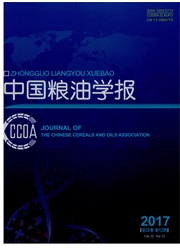

 中文摘要:
中文摘要:
Starch is the major component of wheat flour and serves as a multifunctional ingredient in food industry. The objective of the present study was to investigate starch granule size distribution of Chinese wheat cultivars, and to compare structure and functionality of starches in four leading cultivars Zhongmai 175, CA12092, Lunxuan 987, and Zhongyou 206. A wide variation in volume percentages of A- and B-type starch granules among genotypes was observed. Volume percentages of A- and B-type granules had ranges of 68.4–88.9% and 9.7–27.9% in the first cropping seasons, 74.1–90.1% and 7.2–25.3% in the second. Wheat cultivars with higher volume percentages of A- and B-type granules could serve as parents in breeding program for selecting high and low amylose wheat cultivars, respectively. In comparison with the B-type starch granules, the A-type granules starch showed difference in three aspects:(1) higher amount of ordered short-range structure and a lower relative crystallinity,(2) higher gelatinization onset(T_o) temperatures and enthalpies(ΔH), and lower gelatinization conclusion temperatures(T_c),(3) greater peak, though, and final viscosity, and lower breakdown viscosity and pasting temperature. It provides important information for breeders to develop potentially useful cultivars with particular functional properties of their starches suited to specific applications.
 英文摘要:
英文摘要:
Starch is the major component of wheat flour and serves as a multifunctional ingredient in food industry. The objective of the present study was to investigate starch granule size distribution of Chinese wheat cultivars, and to compare structure and functionality of starches in four leading cultivars Zhongmai 175, CA12092, Lunxuan 987, and Zhongyou 206. A wide variation in volume percentages of A- and B-type starch granules among genotypes was observed. Volume percentages of A- and B-type granules had ranges of 68.4–88.9% and 9.7–27.9% in the first cropping seasons, 74.1–90.1% and 7.2–25.3% in the second. Wheat cultivars with higher volume percentages of A- and B-type granules could serve as parents in breeding program for selecting high and low amylose wheat cultivars, respectively. In comparison with the B-type starch granules, the A-type granules starch showed difference in three aspects:(1) higher amount of ordered short-range structure and a lower relative crystallinity,(2) higher gelatinization onset(To) temperatures and enthalpies(ΔH), and lower gelatinization conclusion temperatures(Tc),(3) greater peak, though, and final viscosity, and lower breakdown viscosity and pasting temperature. It provides important information for breeders to develop potentially useful cultivars with particular functional properties of their starches suited to specific applications.
 同期刊论文项目
同期刊论文项目
 同项目期刊论文
同项目期刊论文
 QTL mapping of starch granule size in common wheat using recombinant inbred lines derived from a PH8
QTL mapping of starch granule size in common wheat using recombinant inbred lines derived from a PH8 期刊信息
期刊信息
